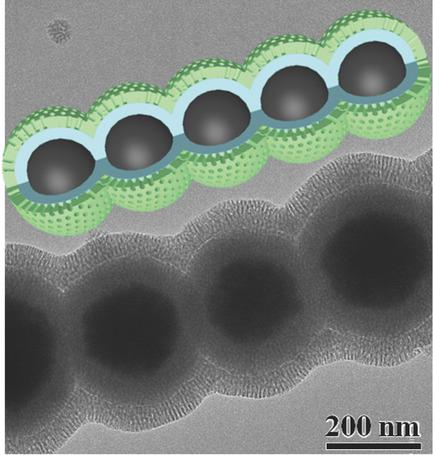当前位置:
X-MOL 学术
›
Adv. Mater.
›
论文详情
Our official English website, www.x-mol.net, welcomes your
feedback! (Note: you will need to create a separate account there.)
A Magnetic‐Field Guided Interface Coassembly Approach to Magnetic Mesoporous Silica Nanochains for Osteoclast‐Targeted Inhibition and Heterogeneous Nanocatalysis
Advanced Materials ( IF 27.4 ) Pub Date : 2018-05-07 , DOI: 10.1002/adma.201707515 Li Wan 1 , Hongyuan Song 2 , Xiao Chen 2 , Yu Zhang 1 , Qin Yue 1 , Panpan Pan 2 , Jiacan Su 2 , Ahmed A. Elzatahry 3 , Yonghui Deng 1, 4
Advanced Materials ( IF 27.4 ) Pub Date : 2018-05-07 , DOI: 10.1002/adma.201707515 Li Wan 1 , Hongyuan Song 2 , Xiao Chen 2 , Yu Zhang 1 , Qin Yue 1 , Panpan Pan 2 , Jiacan Su 2 , Ahmed A. Elzatahry 3 , Yonghui Deng 1, 4
Affiliation

|
1D core–shell magnetic materials with mesopores in shell are highly desired for biocatalysis, magnetic bioseparation, and bioenrichment and biosensing because of their unique microstructure and morphology. In this study, 1D magnetic mesoporous silica nanochains (Fe3O4@nSiO2@mSiO2 nanochain, Magn‐MSNCs named as FDUcs‐17C) are facilely synthesized via a novel magnetic‐field‐guided interface coassembly approach in two steps. Fe3O4 particles are coated with nonporous silica in a magnetic field to form 1D Fe3O4@nSiO2 nanochains. A further interface coassembly of cetyltrimethylammonium bromide and silica source in water/n‐hexane biliquid system leads to 1D Magn‐MSNCs with core–shell–shell structure, uniform diameter (≈310 nm), large and perpendicular mesopores (7.3 nm), high surface area (317 m2 g−1), and high magnetization (34.9 emu g−1). Under a rotating magnetic field, the nanochains with loaded zoledronate (a medication for treating bone diseases) in the mesopores, show an interesting suppression effect of osteoclasts differentiation, due to their 1D nanostructure that provides a shearing force in dynamic magnetic field to induce sufficient and effective reactions in cells. Moreover, by loading Au nanoparticles in the mesopores, the 1D Fe3O4@nSiO2@mSiO2‐Au nanochains can service as a catalytically active magnetic nanostirrer for hydrogenation of 4‐nitrophenol with high catalytic performance and good magnetic recyclability.
中文翻译:

磁性介孔二氧化硅纳米链的磁场引导界面组装方法,用于破骨细胞靶向抑制和非均相纳米催化
具有中孔的一维核-壳磁性材料由于其独特的微观结构和形态而非常需要用于生物催化,磁性生物分离以及生物富集和生物传感。在这项研究中,一维磁性介孔二氧化硅纳米链(FE 3 ö 4 @nSiO 2 @mSiO 2纳米链,命名为FDUcs-17C MAGN-MSNCs)的轻便通过一种新颖的磁场引导的界面合成coassembly在两个步骤中的办法。Fe 3 O 4颗粒在磁场中涂有无孔二氧化硅,形成1D Fe 3 O 4 @nSiO 2纳米链。另一接口coassembly的十六烷基三甲基溴和在水中二氧化硅源/ Ñ至1D MAGN-MSNCs与芯-壳-壳结构,均匀的直径(≈310纳米),和大介孔垂直(7.3纳米),高-己烷双液体系统引线表面积(317 m 2 g -1)和高磁化强度(34.9 emu g -1)。在旋转磁场下,中孔中负载唑来膦酸盐(用于治疗骨疾病的药物)的纳米链表现出有趣的抑制破骨细胞分化的作用,这是由于其一维纳米结构可在动态磁场中提供剪切力,从而诱导足够的破骨细胞。细胞中的有效反应。此外,通过在中孔中负载金纳米颗粒,一维铁3 O 4 @nSiO 2 @mSiO 2 -Au纳米链可以用作催化活性的磁性纳米促进剂,用于4-硝基苯酚的氢化,具有较高的催化性能和良好的磁可循环性。
更新日期:2018-05-07
中文翻译:

磁性介孔二氧化硅纳米链的磁场引导界面组装方法,用于破骨细胞靶向抑制和非均相纳米催化
具有中孔的一维核-壳磁性材料由于其独特的微观结构和形态而非常需要用于生物催化,磁性生物分离以及生物富集和生物传感。在这项研究中,一维磁性介孔二氧化硅纳米链(FE 3 ö 4 @nSiO 2 @mSiO 2纳米链,命名为FDUcs-17C MAGN-MSNCs)的轻便通过一种新颖的磁场引导的界面合成coassembly在两个步骤中的办法。Fe 3 O 4颗粒在磁场中涂有无孔二氧化硅,形成1D Fe 3 O 4 @nSiO 2纳米链。另一接口coassembly的十六烷基三甲基溴和在水中二氧化硅源/ Ñ至1D MAGN-MSNCs与芯-壳-壳结构,均匀的直径(≈310纳米),和大介孔垂直(7.3纳米),高-己烷双液体系统引线表面积(317 m 2 g -1)和高磁化强度(34.9 emu g -1)。在旋转磁场下,中孔中负载唑来膦酸盐(用于治疗骨疾病的药物)的纳米链表现出有趣的抑制破骨细胞分化的作用,这是由于其一维纳米结构可在动态磁场中提供剪切力,从而诱导足够的破骨细胞。细胞中的有效反应。此外,通过在中孔中负载金纳米颗粒,一维铁3 O 4 @nSiO 2 @mSiO 2 -Au纳米链可以用作催化活性的磁性纳米促进剂,用于4-硝基苯酚的氢化,具有较高的催化性能和良好的磁可循环性。









































 京公网安备 11010802027423号
京公网安备 11010802027423号